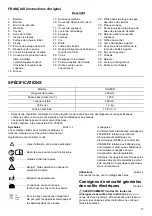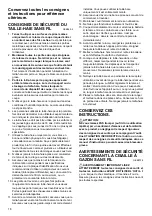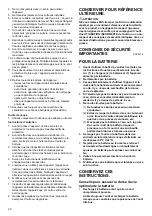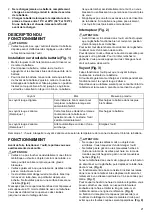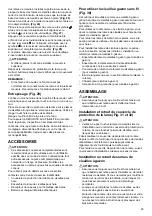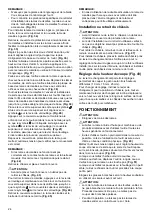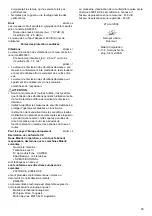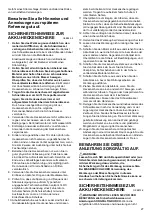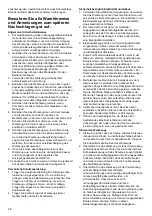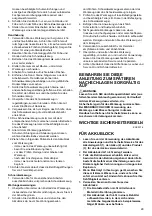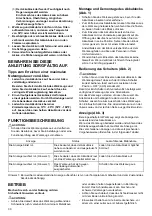
15
To install the grass shear blade, prepare the crank,
undercover and new grass shear blade.
(Fig. 34)
Take out the blade cover from the old shear blades and fit
it onto the new ones for easy handling during the
replacement of blades.
(Fig. 35)
Adjust the three detent pin position so that these pins are
lined up at right angle in relation to the basic alignment
line on the tool housing.
(Fig. 36)
Fit the crank with its recessed part facing upwards onto
the detent pins. At this time, apply a small amount of
grease to the periphery of the crank using grease that the
shear blades as optional accessory are provided with or
that remains inside gear housing.
(Fig. 37)
Overlap the oval hole in the upper blade with that in the
lower one. Move the shear blades so that the hole in the
base plate of shear blades are positioned in the center of
these overlapped oval holes.
(Fig. 38)
Turn the shear blades upside down and install it so that
the detent pins on the tool fit in the hole in the shear
blades. Make sure that the shear blades are set in place
securely as far as they reach the base plate.
(Fig. 39)
Place the undercover so that the symbol on the
undercover is aligned with the symbol on the locking
lever.
(Fig. 40)
Press the undercover down and with the undercover
pressed down turn the undercover clockwise until the
symbol on the label is aligned with the symbol on the
locking lever (the undercover is completely locked).
(Fig. 41)
At this time, make sure that the locking lever fits in the
groove in the undercover.
Remove the blade cover and then turn on the tool to
check it for proper movement.
NOTE:
• When the shear blades does not operate properly,
there is a poor fit between the blades and crank. Redo
from the beginning.
(Fig. 42)
Remove the base frame and place the tool upside down.
CAUTION:
• Before placing the tool upside down, be sure to remove
the base frame.
(Fig. 43)
To remove the shear blade, press the locking lever and
with the locking lever pressed turn the undercover
counterclockwise until the symbol on the undercover is
aligned with the symbol on the locking lever.
(Fig. 44)
Take out the undercover, shear blade and crank in order
from the tool.
(Fig. 45)
NOTE:
• In the 2-way usage, the removed hedge shear blade
need to be sheared in the blade storage case and then
stored for future use.
Installing or removing base frame
CAUTION:
• Before installing or removing base frame, be sure to
install the blade cover.
• When installing or removing base frame, take care that
your fingers are not be pinched between the tool and
base frame.
(Fig. 46)
To remove the base frame, upset the tool and take it out
of the groove grabbing its bottom.
(Fig. 47)
To install the base frame, fit the protrusion of base frame
near the change lever into the hole for the sheared grass
height setting. With the base frame so fitted, pull the lower
part of base frame and fit the other part of the base frame
in the groove in the tool.
Adjusting the shearing height (Fig. 48)
Changing the position of holding the change lever allows
three-stepped setting for sheared grass height (10 mm,
15 mm, 25 mm).
To change setting, tilt the change lever for the base frame
position and with the change lever tilted move it up or
down along the tool surface until the protrusion on base
frame fits in one of the holes in the tool and release it.
OPERATION
WARNING:
• Keep hands away from blades.
CAUTION:
• Smear the blade before and once per hour during
operation using machine oil or similars.
• Avoid operating the tool under the scorching sunlight
as much as practicable. When operating the tool, be
careful of your physical conditions.
(Fig. 49)
Turn the tool on after adjusting the shearing height and
hold it so that the foot of the tool rest on the ground. Then
gently move the tool forward into the area to be cut.
(Fig. 50)
When trimming around curb, fence or trees, move the tool
along them. Be careful for the blade not to contact them.
(Fig. 51)
When trimming sprouts or foliage of a small tree, remove
the base frame from the tool and cut little by little.
Shear big branches to your desired height beforehand
using branch scissors before using this tool.
CAUTION:
• When trimming twigs and foliage, do not attempt to trim
too much at a time. Proceed gently. Also do not
attempt to cut thick branches.
• Do not let the shear blades contact the grounds during
operation. The blades will be dulled, causing poor
performance.
• Do not trim wet grass or foliage of small trees.
Noise
ENG104-2
The typical A-weighted noise level determined according
to EN60745:
Sound pressure level (L
pA
): 73.7 dB (A)
Uncertainty (K): 2.5 dB (A)
The noise level under working may exceed 80 dB (A).
Wear ear protection.
Vibration
ENG244-1
The vibration emission value determined according to
EN60745:
Vibration emission (a
h
): 2.5 m/s
2
or less
Uncertainty (K):1.5 m/s
2
ENG901-1
• The declared vibration emission value has been
measured in accordance with the standard test method
and may be used for comparing one tool with another.
• The declared vibration emission value may also be
used in a preliminary assessment of exposure.
Summary of Contents for UH200DZ
Page 2: ...2 1 2 3 4 5 6 7 8 1 2 3 4 5 6 7 8 9 ...
Page 3: ...3 9 10 11 12 13 14 15 16 10 11 12 13 14 15 16 17 18 19 20 17 ...
Page 4: ...4 17 18 19 20 21 22 23 24 21 22 23 22 17 23 24 25 22 26 25 27 28 29 30 16 31 ...
Page 5: ...5 25 26 27 28 29 30 21 18 17 32 18 33 34 35 36 37 ...
Page 6: ...6 31 32 33 34 35 36 37 38 23 37 16 22 17 23 16 23 24 25 27 25 22 26 30 29 28 ...
Page 7: ...7 39 40 41 42 43 44 17 18 32 18 16 17 18 19 20 17 23 22 ...
Page 8: ...8 45 46 47 48 49 50 51 36 38 37 39 40 37 39 40 37 ...
Page 88: ...ALA Makita Corporation Anjo Aichi Japan 884948 999 ...

















